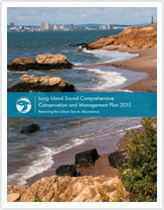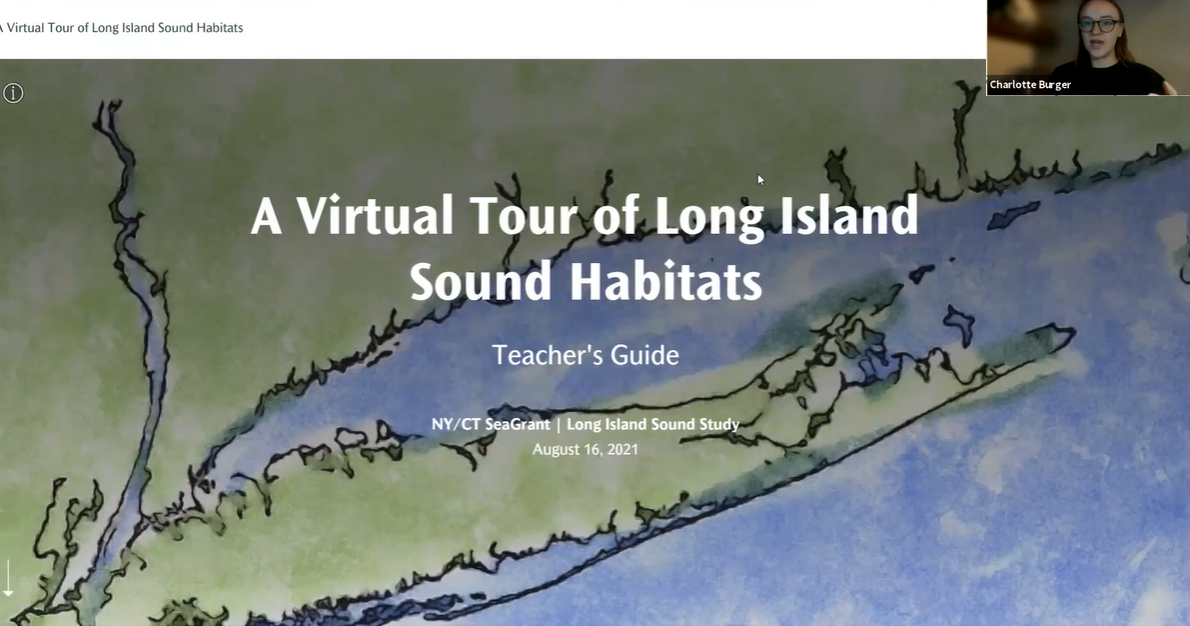Thriving Habitats and Abundant Wildlife
Goal
Restore and protect the Sound’s ecological balance in a healthy, productive, and resilient state to benefit both people and the natural environment.
The natural and cultural heritage of Long Island Sound is inextricably connected to its living resources. For hundreds of years, humans living along Long Island Sound have relied on the land and wildlife for food, shelter, and other day-to-day necessities. To this day, we still rely on fish and shellfish populations to contribute to the economy and ecosystem, benefiting the residents of all watershed communities. Moreover, the protection and restoration of ecologically significant shorelines and habitats of Long Island Sound will serve to protect the diversity and richness of native species, enhance the public’s enjoyment of active and passive recreational opportunities such as hunting, boating, and wildlife viewing, and increase the resiliency of communities to storms and flooding.
The Long Island Sound Study has targeted 12 types of coastal habitats for restoration to sustain living resources and ecosystem services: Beaches and Dunes, Cliffs and Bluffs, Estuarine Embayments, Coastal and Island Forests, Freshwater Wetlands, Coastal Grasslands, Intertidal Flats, Rocky Intertidal Zones, Riverine Migratory Corridors, Submerged Aquatic Vegetation Beds, Shellfish Reefs and Tidal Wetlands. Program partners have restored and/or protected thousands of acres of habitat, opened hundreds of river miles to migratory fish and other wildlife species, implemented ecosystem management plans, and funded multiple research and monitoring projects to provide insight into wildlife and ecosystem function.
Despite these successes, much still needs to be done to improve and protect the species and habitats found within and around the Long Island Sound. In addition, warming waters and sea-level rise pose new threats to habitats and wildlife, and there is an improved understanding of the impacts of previously reported threats such as nitrogen pollution and invasive species. So while the Thriving Habitats and Abundant Wildlife theme continues to emphasize monitoring, research, restoration, and protection, it includes new approaches, such as developing resilient coastal habitats through the creation of living shorelines and green infrastructure, to address current and future threats to habitats and wildlife. The natural habitats of Long Island Sound and its coastal areas support diverse populations of wildlife and living resources, provide recreational opportunities, and function as an environmental infrastructure that provides services and benefits to the region. The Thriving Habitats and Abundant Wildlife theme addresses the balance between people and the natural environment and the need to continue restoration and protection of priority habitats and wildlife to sustain a healthy, productive, and resilient Long Island Sound benefiting all inhabitants. All of the goals and actions outlined in this theme should provide multiple benefits to both wildlife and humans alike.*
Ecosystem Targets
The following ambitious, but achievable, ecosystem targets have been developed to drive progress toward attaining the Thriving Habitats and Abundant Wildlife (HW) goal.
Restore an additional 350 acres of coastal habitat by 2020 from a 2014 baseline.
Restore and maintain an additional 2,000 acres of eelgrass by 2035 from a 2012 baseline of 2,061.
Restore an additional 515 acres of tidal wetlands by 2035 from a 2014 baseline.
Open 200 additional miles of fish riverine migratory corridors in the Connecticut and New York portions of the watershed by 2035 from a 2014 baseline of 307.76 miles.
View River Miles Restored for Fish Passage Environmental Indicator
Increase the harvest of oysters, clams, and scallops in the Sound through a combination of habitat management and shellfish aquaculture.
Increase connectivity of coastal habitat by 2035 by restoring and/or protecting habitat patches that increase biodiversity and support migratory pathways.
Conserve an additional 4,000 acres of Connecticut land and 3,000 acres of New York land within the Long Island Sound coastal boundary by 2035, while maintaining or increasing the total area of protected land.
Challenges
- Tidal marshes and other coastal habitats are threatened with drowning from rising seas if they cannot build upward or migrate inland because of natural or man-made barriers.
- The balance among coastal habitats such as marshes, beaches, dunes, grasslands, and forests has been altered due to development, decreasing the resiliency of Long Island Sound.
- Remaining open spaces along the coast are under development pressure.
- Invasive/nonnative species threaten ecosystem diversity and compete with native animals & plants.
- Development and use of the coastal zone conflicts with the needs of some wildlife species (e.g., roseate terns) for forage and nursery areas.
Solutions
- Identify and conserve open space landward of coastal habitats to allow for natural transition upland.
- Enhance the resiliency of coastal habitats by strengthening living shorelines such as marshes, beaches, and dunes.
- Understand the historic balance of natural habitats and work to restore the desired values and functions of the ecosystem.
- Prioritize open space protection to save the last remaining high-value undeveloped lands.
- Develop site management plans for eliminating invasive/nonnative species, involving community organizations and volunteers.
- Involve communities in the stewardship of wildlife.
What’s Being Done
Find examples below of actions being undertaken by LISS and its partners to achieve outcomes that will help meet the ecosystem targets and achieve the CCMP goals for restoring and protecting habitats and wildlife.
- The LISS Habitat Restoration Initiative is restoring coastal habitats (2,056 acres by 2019) and opening river miles (419 by 2019) for fish passage. Learn more in the Habitat Restoration Initiative web page.
- The LISS Stewardship Initiative has identified 33 places as Long Island Sound Stewardship Areas, unique habitats that receive grants support from the Futures Fund to restore and protect the lands and surrounding waters and promote sustainable recreation. Learn more in the Stewardship Initiative web pages.
- Connecticut and New York are 48 percent as of 2019 towards a goal to protect 7,000 acres of open space by 2035 through acquisitions. Learn more in the Protected Open Space ecosystem target.
- Connecticut and New York are implementing state invasive species management plans that seek to restore diverse and balanced ecosystems when invasive species out-compete native populations. Learn more in the CT DEEP and NY Invasive Species Information websites.
- Connecticut, New York, and the federal government are implementing plans to protect species at risk of extinction, including coastal birds such as the piping plover and least terns. The Futures Fund provides grants to help restore habitats populated by targeted list species and outreach to educate citizens on protecting habitats. Learn more in the CT DEEP, NYSDEC, and USFWS websites.
- Connecticut and New York are implementing Wildlife Action Plans to promote projects that protect biological and ecological diversity. Learn more in the CT DEEP and NYSDEC websites.
- Long Island Sound organizations invite citizens to volunteer for projects to restore and protect Long Island Sound habitats. LISS staff helps organize volunteer projects at Stewardship Sites. Learn more in the Get Involved section of the LISS website.
- LISS recruits volunteers in Long Island and Westchester to monitor alewife populations to collect data to help assess the need for river restoration project.
- Local organizations sponsor cleanups to pick up trash on beaches and coastal parks. Learn more about Connecticut efforts in the Save the Sound website and New York efforts in the American Littoral Society website.
- The Long Island Sound Study uses social media to raise awareness of the impact of marine trash to wildlife. Learn more about the #DontTrashLISound campaign in the LISS media center..
- The Long Island Sound Study and partners monitor the extent salt marsh habitats keep up with sea level rise using Surface Elevation Tables.
- Connecticut and New York conduct trawl and other fish surveys to monitor fish populations in Long Island Sound.
- Project Limulus in Connecticut and NYSDEC monitor populations of horseshoe crabs, one of the world’s oldest species.
- Connecticut and New York are using models that can be viewed by the public on-line that show the possible impacts from sea-level rise on saltmarsh habitats and roads.
- The Long Island Sound Study provides information to resource managers on emerging trends in protecting habitats at quarterly meetings and through tidal wetlands workshops.
 For More Information
For More Information
The full description of the actions, strategies, objective and outcomes for Long Island Sound Study can be found in the Comprehensive Conservation and Management Plan.
